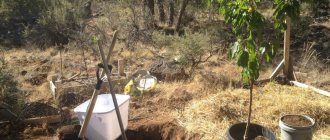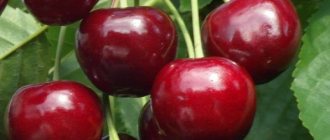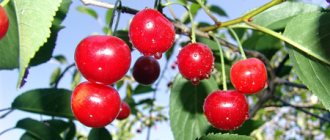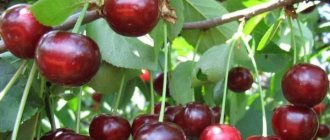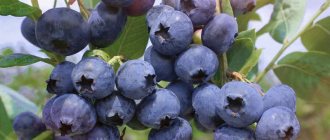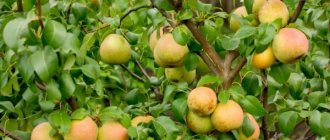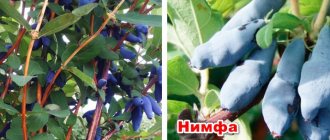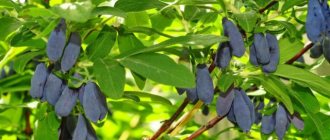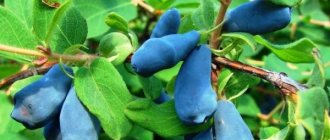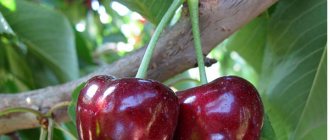Photo and description
The German cherry variety is successfully cultivated in warm regions of the country up to the Middle Volga region. This is ensured by two important qualities of Regina - resistance to frost and disease. The tree grows up to 3.5-4 meters, has a crown of medium branching and density.
general description
Regina is classified as an unpretentious variety, therefore it is successfully grown on large farms. Flowering and fruit ripening occur annually. The tree blooms at the end of May, the fruits ripen at the end of July, Regina is a late-ripening variety that ends the cherry season.
Cherries can be stored on the tree for a long time, which is important for busy summer residents; they store well and are transported without loss of taste. The fruits do not leak juice and do not become wet.
Advantages
The list of benefits of the variety is quite impressive:
- taste, beauty and decorativeness of fruits;
- long-term storage without loss of quality, ensured by dry separation;
- annual fruiting of cherries;
- ripe fruits remain on the tree for up to 2 weeks.
Let us also note the very relevant properties of this cherry variety for Russia - winter hardiness and resistance to fungal diseases.
Flaws
Gardeners consider the only disadvantage of Regina to be the need to plant a pollinator, without which it will not be possible to obtain fruits.
Bud
Cherry buds develop late and tolerate frost well at any stage of development. Sawflies are especially dangerous for the buds and can greatly harm the tree.
Leaf and flower
The sheets have a traditional shape - an ellipse, the end is slightly pointed. The edges are serrated. The surface of the plate is glossy and shiny.
The flowers are collected in 2-3 pieces, the petals are white, the cherry blossoms are abundant and friendly.
Fetus
The fruits are round-heart-shaped, evenly and uniformly colored.
Weight
The average weight of cherries is 8.5 grams; when grown in good conditions, they reach 10-11 grams.
Height
The height of the fruit is slightly larger than the width - 2.5-3.2 centimeters.
Width
The diameter of the cherry is 2.5-3.2 centimeters.
Thickness
The thickness of the fruit pulp depends on the conditions of care and is 0.5-0.9 centimeters.
Color
Exquisite dark cherry color and shiny glossy skin attract attention to large fruits. The pulp is slightly lighter than the cherry shell.
peduncle
The stalk comes off the fruit easily and does not take the pulp with it, so the berries are stored for a long time.
Bone
The stone is medium in size and can be easily separated from the pulp.
general characteristics
The pulp of the berries is dense, without excess juice, gristly. Included in the bigarro class.
Taste qualities
Regina's taste qualities are close to ideal - score 4.8-5 points. The taste of cherries is sweet, with a slightly noticeable sourness.
Nutrient content
Regina demonstrates all the best qualities of cherries. The berries contain:
- carbohydrates – up to 16%;
- fructose, sucrose;
- vitamins B, C, E;
- potassium, iodine, iron, calcium.
There are no fats in the fruits, the content of pectins is high.
Tree height and growth rate
The tree grows up to 3-4 meters, adding up to 50 centimeters annually. The shoots grow upward, which facilitates the formation of the crown.
Flowering and ripening period
Regina begins flowering when most of its relatives have long faded - in mid-to-late May. The fruits also begin to ripen late - in mid-to-late July. If the fruits last a long time, you can eat fresh cherries for most of August.
Productivity
The first cherry harvest is harvested in 3-4 years. A remarkable property of Regina is its annual flowering and fruiting, which does not depend on the vagaries of the weather. An adult tree produces up to 40 kilograms of fruit.
Transportability
Dry tearing allows the fruit to remain firm and whole for up to 3 weeks. The harvest is well stored and can be transported over any distance without losing quality. The dense pulp does not flow, the skin is not injured.
Drought resistance
For successful development at all stages of the growing season, cherries need sufficient moisture. The variety is not considered drought-resistant. Watering is monthly; the soil layer at the roots should be free of cracks and obvious signs of drying out. When the soil dries out after watering, it is loosened.
Frost resistance
A healthy tree can withstand frosts down to -25°, which makes Regina popular and in demand among gardeners.
Disease resistance
Regina is considered one of the most resistant cherry varieties. In humid, cloudy weather, watering is reduced to avoid rot on the fruit.
Application of fruits
The use of fruits is universal:
- the best taste is fresh until mid-August;
- freezing;
- preparing desserts;
- compotes and other types of preservation.
Keeping quality, preservation of taste after transportation and long-term storage make the variety popular in agricultural farms for industrial cultivation.
Basic soil requirements
Cherry grows well in loamy and sandy loam soils. When preparing a site for planting, the soil is enriched to this state. Clay is added to sandy soils; it retains moisture well. Clay soil is combined with river sand to make it lighter and looser.
Any type of soil must be fertilized and mixed with organic matter to provide nutrition to the seedling. It is recommended to prepare the soil in advance, 1-2 years in advance, so that the land acquires fertile properties.
Regina sweet cherry description of the variety - Summer Resident's Guide
- 1 Regina cherry: characteristics and description of the variety
- 2 Cherry
- 3 Regina Cherry: variety description + photos, reviews
- 4 Regina cherry: description of the variety, pollinators, photos, reviews
- 5 Regina cherry: description of the variety, photos, reviews
Regina cherry is a late variety, the fruits of which ripen at the end of July and can be on the tree until the beginning of August.
It was bred in Germany, therefore it is adapted to a mild climate and in Russia it is suitable mainly for the southern and central regions.
The variety has good survival rate and active growth. The first harvest can be harvested already in the third season from the moment of planting.
Description of the variety
The tree of this variety has a medium-sized crown with moderate density. The variety is one of the latest and has high fruiting rates.
The amount of harvest increases as the crown grows without cyclicity, when the ovary does not form every few seasons. To maintain the large size and sweetness of the fruits, periodic sanitary pruning is necessary.
Regina tolerates frost well, so the branches practically do not die off.
When selecting the variety, it was possible to achieve good resistance of the tree to bark diseases, bacterial and viral infections. Regina is considered one of the easiest varieties to care for.
A tree, even in a neglected state, when preventive treatment and sanitary pruning are not carried out, can produce a good harvest, although its quality will be lower.
Choosing this variety will be an excellent solution for novice gardeners who do not have sufficient experience in caring for cherries.
Regina is great for home and industrial gardens. The tree is self-pollinating, so the presence of another variety in the neighborhood is not necessary, but its presence can increase the yield.
In addition, the crown is quite flexible and can easily withstand the weight of a person, which is important for home growing, where children can climb the tree.
Pollination of flowers
Although Regina is a self-pollinating variety, when placed next to other cherries that bloom at the same time, the percentage of fertilized flowers increases significantly, which has a positive effect on productivity. The main problem is the difficulty of selecting neighboring varieties that would bloom during the same period. The best pollinators for Regina are:
- Karina;
- Hedelfinska;
- Bianca;
- Silvia;
- Schneider late,
- cherry Lotovka.
If a tree is planted in a small area where it is not possible to place two cherries, then one of the proposed varieties can be grafted onto Regina’s crown. In this case, it will be possible to increase the efficiency of sawdusting, since the tree will have branches of different cherries.
If there are apiaries with bees in the neighborhood, insects significantly increase productivity because they transfer pollen between flowers of the same crown.
In a home garden, where there is no need to have two cherry trees due to excess harvest, you can plant Lotovka cherry, as well as Nefris or Coral, next door.
Benefits of the fruit
The Regina cherry variety is characterized by large fruits that weigh 8-11 grams when ripe. Weight depends on the degree of crown density, soil quality and moisture availability. When describing the fruits, a number of characteristics can be noted:
- uniform dark red color;
- round shape;
- hard pulp;
- high juice content;
- sweet taste;
- increased transportability.
The harvest from the Regina variety tree is excellent for sale. The fruits are well preserved and are not crushed in boxes under their own weight, as happens with early varieties. Harvested cherries can sit for up to 10 days without the risk of rotting or wilting. In this case, you need to ensure that damaged fruits do not fall into the box with whole fruits.
Large size makes harvesting easier. Cherries hang on the tree for a long time and do not spoil, so having this variety in the garden allows you to enjoy the pleasant taste for a long time until mid-August. The fruits are resistant to cracking, which prevents damage to the crop in rainy weather.
Planting and caring for a tree
Second year seedlings are mainly selected for planting. They are planted in autumn or spring. The highest survival rate is shown by trees planted in autumn, when the seasonal growth cycle ends and the seedling goes into a dormant state.
When choosing to plant before winter, there is a risk of the seedling freezing, so it will have to be insulated. In autumn, cherries are planted in November, and in spring in March-April.
Before digging a hole, you should choose the optimal place for planting. It should be:
- sunny or have partial shade;
- protected from the wind;
- distance to other trees is at least 3 m;
- The depth of groundwater is not higher than 1.5 m.
When preparing a hole, its parameters must be selected so that the pit is 2 times larger than the size of the root system. Usually a hole of 60x60x60 cm is dug for Regina. The best soil is loam and sandstone, but survival occurs in almost any soil except clay and clean sand.
To fertilize a hole of the recommended size, you need to prepare 10 kg of organic fertilizer, which should be mixed with soil selected from the pit. Part of the mixture is placed on the bottom in the form of a mound.
The cherry trunk is placed in the center of the resulting mound, and the roots are straightened along its slopes.
Next, you need to fill the soil up to the root collar without compacting it and add 10 liters of water if planting in autumn, and 20 liters for spring planting.
If a seedling is planted in the spring, especially at the end of the planting season, then its roots must first be kept in water for about 8-10 hours. For better survival, growth stimulants can be used.
After planting, the tree must be tied to a stake so that the trunk is held straight and the crown is formed evenly. Watering is carried out periodically immediately after the soil dries. Usually one bucket every 3-4 days is enough, and in cloudy weather even less often. The soil above the seedling needs to be periodically fluffed up so that it does not crack.
In order to increase yield, you can water trees that are at the age of fruiting. For them, water is added in an amount of 60-100 liters, depending on the size of the crown and the intensity of soil absorption.
Having Regina cherries in their garden, many gardeners who sell their crops value this variety very much and strive to propagate it themselves. In this case, it is important to choose a good rootstock.
For this purpose, the Antipka and F 12/2 varieties should be avoided, since the resulting tree begins to bear fruit late and has low yield.
The best rootstocks for Regina are Gisella-5, as well as dwarf varieties.
As for pruning, the Regina cherry variety is not at all demanding, so only internal shoots that shade the main branches are removed, and broken or shriveled parts of the crown are also removed. The sanitary cut is carried out in early March, and the cut site is covered with garden pitch.
The Regina variety of cherries is very easy to care for and can be grown even by novice gardeners; moreover, it quickly enters the fruiting stage. The only drawback of the variety is its weak natural self-pollination, but all this can be solved by the proximity of other cherries.
Source: https://agro-akcent.com/chereshnya-regina-opisanie-sorta/
Landing Features
When planting, it is important to strictly follow all the requirements so that the seedling quickly grows and develops fully.
See also
How to properly graft cherries in the summer with young green eyelids, methods, timing and careRead
Selection of seedlings
Agronomists recommend choosing locally selected seedlings that are better adapted to the characteristics of the region. It is better to buy cherries at a nursery than at street markets or order them online.
Let's look at how to choose a cherry seedling.
Root system
A healthy root will ensure rapid establishment and adequate nutrition of the plant. Root system requirements:
- 3 large roots with small branches;
- absence of rot, creases;
- white and juicy when cut;
- Elastic - bends rather than breaks.
The root should be moistened and covered with soil. When transporting it, cover it with a damp cloth.
Trunk
The size of the seedling is 1-1.5 meters. The trunk is smooth, without cracks, 3-5 branches more than 30 centimeters long. The kidneys are whole and alive.
Age
Young seedlings 1-2 years old take root best.
Important: seedlings older than 3 years should not be purchased.
Availability of vaccinations
Only grafted seedlings provide varietal identification of cherries. Regina's bones grow into wild animals. The grafting site is healthy, intact, without rotting or cracks.
Choosing a landing time
Cherries are planted in spring and autumn. The period depends on the climatic characteristics of the region and the availability of seedlings on the market. In any season, it is important to plant Regina in time so that the seedling develops in favorable conditions, takes root and grows.
Autumn
Before winter, cherries are planted in warm regions with mild winters and hot summers.
Advantages
Advantages of autumn planting:
- the growing season is completed, all the energy of the cherry goes to rooting;
- wet autumn reduces the need for watering;
- In the spring, a tree that has taken root over the winter tolerates heat more easily and suffers less from pests.
In hot regions, spring plantings often die due to high soil temperatures and lack of moisture.
Flaws
A sudden cold snap often destroys young plants. Poor rooting leads to the fact that the cherry tree cannot survive a cold winter with little snow and dies. Rodent infestations often destroy young plantings in summer cottages.
Spring
Cherries are planted in spring in most regions of the country. Cold winters are dangerous for weak autumn seedlings - they do not have time to take root and mature.
Advantages
During the warm spring-summer season, the seedling manages to grow roots and gain a foothold in the soil. He has almost six months to do this. You can overcome the effects of the dry period by timely watering. Summer residents can fight diseases and pests by monitoring cherries all summer.
Flaws
In addition to growing roots, the seedling must ensure the growth of branches and leaves, which requires a lot of effort from it. Young plants are often attacked by pests that prefer immature, juicy young growth. Summer residents need to constantly monitor the condition of the seedling - protect it from insects, prevent it from drying out and slowing down the growing season.
The autumn selection of seedlings is always greater; many gardeners purchase cherries at this time, plant them in drops, and plant them in the spring.
Site selection
Heat-loving cherries require a lot of sun and light. It is important to provide it with illumination by choosing a convenient area. Location requirements:
- sunny area - south or west side;
- no stagnation of water, low groundwater flow - 2 meters or more;
- high place without accumulation of fog.
Drafts and cold winds slow down growth; cherries without sun become sour, less juicy and aromatic. It is important to remember that the crown needs ventilation to protect it from rot and harmful insects, so the tree should not be planted in closed corners.
Let us also note the pleasant neighborhood for cherries - cherries, plums, pollinating cherries. It is not recommended to grow apple trees, pears, gooseberries, and raspberries near Regina.
Pit preparation
Time frame for preparing a planting pit for cherries:
- for spring - autumn;
- for autumn planting - 2-3 weeks.
A hole 60-70 centimeters deep and 100 centimeters wide is prepared for the seedling. The upper part of the removed soil is set aside and a soil mixture is prepared from it. The composition of the mixture is soil, humus (2 buckets), complex (phosphorus, potassium) mineral fertilizer, ash.
The prepared soil is poured into a heap at the bottom of the hole, and the future support for the cherries is strengthened in it.
Landing
Before planting, the roots of Regina's seedlings are cut off and placed in water mixed with growth stimulants (Zircon, Kornevin).
The seedling is placed on a mound in a hole so that the grafting site remains above the soil surface. The earth is added in layers and carefully compacted so that no voids form. Having filled the hole halfway, pour in 5-10 liters of water and wait for it to settle.
Fill the hole completely, compact the earth, form a circle and pour in 2 buckets of water. The surface of the root circle is mulched.
We select a seedling and “register” it on the site
Purchase of planting material
It is better to order a seedling in your area. With the development of the Internet, some people can write down a tree from another region and even another country. But Regina grown or grafted in a different climate may not have the winter hardiness that you need.
It is better to buy seedlings in the fall. Moreover, this should be done not on the Internet, but in person, in a nursery, or at least in the market (although here they can deceive you by slipping you the wrong variety).
The ideal plant looks like this:
- from 3 large roots covered with small roots - the roots must be elastic, not break when bent, without rot, growths and swelling, and have white wood on the cuts;
- an even trunk without cracks or wrinkles on the bark, at least a meter high, on which the grafting site should be clearly visible;
- about 4 branches from 35 cm long with whole buds;
- A good seedling is a year or two old.
An experienced gardener will tell you in more detail about inspecting a seedling when purchasing and planting a young tree:
Plant in spring or fall?
Early spring . Option for cold regions and/or winters with little snow. By winter, your tree is guaranteed to take root. But in summer it will have to be watered often. In addition, it is not possible to buy seedlings everywhere in the spring. Often people buy trees in the fall and carefully store them until spring, digging them up.
Autumn . A good option if you have a warm climate. But it is important to have time to send the seedling into open ground at least a month before the onset of frost. That is, in the middle zone it should be at least the end of September, and in the south (the same Crimea) - the beginning of November.
The autumn tree is watered once, immediately after planting. Further watering will be carried out by rains. This seedling will take root very well. However, if the fall is dry, you will have to water the seedling several more times, making sure that rodents do not grow near the roots.
Agrotechnics of planting
- Plot . Cherries should grow in the most comfortable place possible - hide the cherries behind a blank fence or wall of the house. Moreover, it can grow both in the shade and in direct sunlight (the latter is better - the fruits will be sweeter). There should be no strong drafts on the site, but it should not be too dull either. Also, it should not be lowland. If the groundwater is shallow or puddles stagnate in the area for a long time, this place will not be suitable for cherries.
- Soil . Drained, light, yet fertile. Loose sandstone or light loam is ideal. If the soil is “tight”, clayey, dig it up with the addition of sand. And if the soil is acidic, be sure to lime it.
- Planting pit . For autumn planting, a hole is dug a month in advance, for spring planting - in the fall. Its depth should be 70 cm, width - 1 meter. Immediately drive in a one and a half meter peg that will secure the trunk of the seedling. Place the top soil aside, mixing with a liter of wood ash, phosphorus and potassium fertilizers (200 and 100 g, respectively), and 2.5 buckets of well-rotted manure.
- Landing . Soak the tree roots in water. Place part of the nutrient soil in a hole, place the seedling on this pile (the root collar should remain 5 cm above the ground level), spread the roots to the sides. Carefully fill the roots with the remaining prepared soil. Compact the soil and pour 2-3 buckets of water over it. Finally, mulch the soil around the trunk.
- Pollinator . It should bloom at the same time as Regina. It is not necessary to plant another cherry tree - as an option, you can graft a branch of a different variety onto your tree. Even a tree growing from a neighbor (no more than 30 meters from yours) will do if it is: Sylvia, Wanda, late Schneider, Donetsk beauty.
Pollinators
Almost the only drawback of Regina is the obligatory planting of pollinators near the tree. The main difficulty is that we need certain varieties that bloom at the same time. The following varieties of cherries and sour cherries are recommended.
Please note that there is no need to plant a tree on purpose. The neighbors have a growing suitable crop close enough. They also use the recommended variety to graft onto Regina or any neighboring tree.
Schneider late
Cherry is one of Regina's parents. A very high-yielding variety, the fruits are quite sour.
Sam
A well-known pollinator of many varieties. The taste of Sam fruits is slightly bitter. Does not crack in any weather.
Donetsk beauty
An excellent variety with red-pink fruit pulp, cherries - up to 7 grams, sweet and juicy.
Silvia
The tree grows almost without side shoots. Winter insulation is required for many regions. The fruits are sweet and large.
Gedelfinskaya
The variety is very productive, the trees are tall, the crown is thick. The fruits are sweet, juicy, up to 6 grams. The bone does not come off.
Wanda
The fruits are slightly flattened, weight up to 8 grams. The color of the fruit is carmine.
Lapins
Not a winter-hardy cherry variety; it grows well only in warm regions. The berries are juicy, with a pronounced aroma, and remain on the tree for a long time.
Bianca
Regina is planted at a distance of 3 meters for pollination.
Karina
Large fruits are very dark in color, juicy, cone-shaped. Hard, dense bark protects the tree from fungal diseases.
Coral, Lotovka
Cherry Coral blooms late and is short in stature. The pulp is sweet, juicy with a wine flavor. Lotovka (Lutovka) is a cherry variety, practically not used fresh, intended for processing.
Nefris
The cherry variety shows good yield results only in warm regions. Does not have high winter hardiness.
Cordia
A variety of cherries with very dense red pulp, fruit size – up to 10 grams.
Summit
A tree with a powerful crown will take up a lot of space on the site. Fruits - up to 10 grams with light red, slightly sour, aromatic pulp.
The appearance of the variety and its characteristic features
Inspired by the idea of creating cherries with later fruiting, German breeders combined varieties such as “Roubaix” and “Schneidera”.
We were pleased with the result of the work, because a wonderful variety “Regina” with excellent qualities was born. The tree of the developed variety was not very tall, with a rounded crown and an average level of density. The first flowers, which will later turn into fragrant and large berries, bloom already in the third year after the young tree is transplanted to a permanent place.
Regina cherry fruits
The shoots of "Regina" are straight, they are directed upward and develop quite quickly. In the first year of life, the seedling can already boast shoots 45-50 cm long. The inflorescences of the beautiful “Regina” are the same as those of other sweet cherry sisters - an ordinary calyx with small flowers.
The harvested harvest pleases with large dark red fruits. Ripe cherries surprise with their weight - 10-11 g. The pulp of “Regina” is very juicy, fleshy and also dark red in color.
Attention! Unlike other varieties, “Regina” gives the harvest later. Ripe berries appear in mid-summer.
Secrets of care
Proper care not only increases yield, but also improves the taste and size of the fruit, making them sweeter and juicier.
See also
Planting and caring for cherries in Siberia, choosing a variety and mistakes during cultivationRead
Watering
Regina cherry is not drought-resistant and requires regular watering. Their scheme is adjusted depending on humidity and precipitation. During wet summers, reduce the frequency and prevent water from stagnating.
The following standards are recommended:
- young tree – 30 liters once a month;
- adult, fruiting – 50-60 liters at least 3 times per season.
The first watering is carried out during the opening of the buds, then according to the scheme. It is important to adjust the timing and amount of water depending on the weather conditions. During dry summers, watering is increased and the soil in the circle is mulched to retain moisture for the roots.
3 weeks before harvesting, stop watering to prevent the fruits from cracking and becoming sour.
It is important to loosen the soil and destroy weeds in time; cherries do not like them. To avoid damaging the roots, use a fork or a hand cultivator for loosening.
Top dressing
During the first year, Regina feeds on fertilizers applied during planting and does not need additional feeding. Nitrogen fertilizers are applied in small doses (120 grams per circle) in the second year. Urea will ensure the growth of green mass and enhanced vegetation.
From the 3rd year, regular feeding begins:
- humus - once every 2-3 years;
- superphosphate and potassium salt - annually, in the spring.
The trunk circle increases as the crown grows (by 50 centimeters per year). Fertilizers are applied dryly, by digging along the edge of the circle, or in the form of a solution with watering. Sweet cherries love feeding with ash and dolomite flour.
Trimming
At a young age, all improperly growing young shoots are removed from the cherry tree. Damaged, broken branches are cut out throughout their life. The crown should not be thickened; this leads to loss of fruit quality.
The top is of decisive importance; its condition is especially monitored. When stronger branches appear, the main conductor is replaced to avoid competition. Old branches (7-8 years old) are shortened, rejuvenating the cherries and stimulating the growth of young shoots.
Preparing for winter
Regina's frost resistance protects the tree from low temperatures. A young cherry seedling, especially one planted in the spring, needs autumn preparation for cold weather. Main stages of pre-winter preparation:
- Remove old mulch. The trunk is cleaned of damaged bark and whitened with lime.
- The soil in the circle is dug deeply and the cherries are watered.
- Fertilizers are applied 2 weeks before the actual cold snap.
- The soil around the cherries is covered with a layer of mulch of 20 centimeters.
- The trunk of young seedlings is insulated with burlap.
- Protection against rodents is provided by a mesh or spruce branches.
If there is not enough snow, add it manually.
Important: the trunk can be covered in winter only with breathable materials, do not use film.
Prevention from diseases and pests
Regina cherries are well genetically protected from fungal diseases, but with high humidity and lack of ventilation they can suffer from rot and viral infections.
Moniliosis
Gray rot is a fungal infection that often affects fruits in wet summers. Diseased cherries should be removed from the tree, collected from the ground and disposed of. The disease is expressed in fruit rotting and monilial burn (damage to parts of the trunk).
For treatment, biological products (Fitosporin, Fitolavin) and chemicals (Topsin M, iron sulfate, Kuprozan) are used.
Gommoz
This is the name for gum leakage - the flow of juice caused by unfavorable conditions. For treatment, removal of congealed juice and treatment with copper sulfate are used.
Mosaic disease
Viral disease affecting cherry leaves. Yellow stripes appear on the plates along the veins, they curl and fall off. A viral disease cannot be treated. The tree is most often uprooted and destroyed.
Gypsy moth
The pest feeds on any plants and can penetrate cherries from a neighboring forest and completely ruin all plantings. In the fall, they inspect the cherries and pick off all the egg clutches. Treatment with insecticides – Chlorophos, Metaphos.
Black aphid
Small insects settle on the lower part of the foliage and in the forks of the trunk. The foliage becomes sticky and covered with a coating on which dust settles. They use Spark to fight, Commander. It is especially important to fight ants, with which aphids share common vital interests.
Cherry pipe maker
Adult beetles eat ovaries and leaves, the larvae penetrate the seeds and destroy the fruit. The taste qualities of even surviving fruits are lost. It is important to treat cherries with insecticides (Aktara) on time - 4-6 days after flowering, then after another 10 days.
Cherry sawfly
Caterpillars of small insects devour foliage and ovaries. Capable of stripping cherries down to the trunk. They use insecticides - Karbofos, Actellik.
Crown formation
The first time cherry trees are pruned is after spring planting. If Regina is planted in winter, pruning is left until spring. A sparse, tiered, sparse crown is formed. Basic Rules:
- number of branches – 5-10;
- lower branches – 50-60 centimeters from the ground, all small shoots below are removed;
- the distance between tiers is 50-60 centimeters;
- the tier consists of 3 branches;
- at a height of 3.5-4, the growth of cherries is stopped.
It takes 4-5 years to form the crown. Later, the tree is thinned out, old branches are removed, and space is given for young ones to grow.
Treatment in spring
With the arrival of spring, the insulation is removed and the cherry trees are pruned. It is important to remove damaged branches. The pruning areas are coated with copper sulfate and pitch. Until the buds come to life, the cherries are sprayed for protective purposes with urea or other drugs (Nitrophen) against pests and diseases.
Harvest and storage
Cherry fruits are removed from the stalk, especially if they are left for storage. There is no need to quickly harvest the entire crop. Cherries hang on the tree for up to 2 weeks without loss of quality or cracking. It is better to eat freshly picked fruits.
The cherries are cut with scissors or pruning shears and placed in small boxes in 2-3 layers. Store in the refrigerator.
Cherry care Regina
The productivity of cherries largely depends on care. The tree is watered and fed, and the crown is pruned.
Feeding and watering
The first feeding is carried out in early spring, after the snow cover has melted. For Regina cherries, nitrogen fertilizer is prepared: a solution of urea or mullein. The crop requires phosphorus and potassium for fruit formation. From fertilizers take 30 g of potassium salt or superphosphate. Substances are embedded in the soil or dissolved in water for irrigation. It is convenient to combine fertilizing cherries with watering. Moisture is added during the flowering period and at the beginning of fruiting, if there is a drought in the region. With normal precipitation, watering is not required for cherries.
Weeding and loosening
The soil in the tree trunk circle is regularly weeded. After watering or rain, the soil is loosened so that the cherries better absorb moisture and minerals. For loosening, use a fork, cultivator or other garden tools.
Crown formation
The Regina variety has a tiered, sparse crown. This process takes 5-6 years. In each tier, 3 powerful shoots are left, the remaining branches are cut out. The central conductor is shortened and the height of the tree is maintained at 3-3.5 m. 0.5 m is left between levels. Branches with signs of disease, as well as broken and frozen shoots, are removed annually.
Reviews
The quality of the fruit, unpretentiousness and good winter hardiness of Regina are advantages that are noted by all amateur gardeners and farm owners. Cherries lie and remain on the tree for a long time, delighting with a long period of fresh consumption. You can make delicious preparations for the winter from the fruits.
The main difficulty is choosing and planting a pollinator that is suitable for flowering time. When solving this problem, growing Regina does not cause any other problems.
Regina cherry is a wonderful variety that allows you to get tasty fruits even in not the warmest regions. The variety is gradually becoming beloved and popular among summer residents. The southern guest is gaining a place in summer cottages, delighting with dark, fleshy fruits and a long fruiting period.
Characteristics
Here are the main characteristics of the Regina cherry variety.
Drought resistance, winter hardiness
Cherry is not a drought-resistant crop. To get a good harvest, the tree needs to be watered at least once a month. In dry weather, make sure that the soil at the roots does not dry out.
Regina tolerates winter quite well if it is not grown in the northern regions. Young seedlings need to be spudded and tied with burlap or other rodent-proof material.
Pollination, flowering period and ripening time
The plant is not self-pollinating, and it is not always possible to choose a late-flowering variety. Pollinators for Regina cherries are the Karina and Salvia cherries; you can use Lotivka and Coral cherries. They are planted closer to the tree to be pollinated. The Regina variety blooms in May, the fruits reach maturity by mid-July.
Productivity, fruiting
The tree is strewn with berries every year. Not all of them can ripen, but up to 40 kg of fruit can be collected from an adult tree. It begins to bear fruit three years after planting.
Regina cherry fruits are stored on the tree in ripe form for 10-12 days. They don't crack from rain.
Attention! The only danger for the berries is that birds love them very much. If harvested untimely, they can deprive the gardener of the harvest.
Area of application of berries
The juicy sweet berry is used fresh. Various products are made from it. In addition to desserts, wines and liqueurs are good. For winter use, the berries are frozen. Cherry fruits are well transported and quickly sorted by buyers.
Resistance to diseases and pests
A specially bred variety is resistant to many diseases of cherries. In cold and wet weather, various putrefactive formations may appear on the fruits.
Advantages and disadvantages
The advantages of Regina cherries include the following qualities:
- High annual yield.
- Good preservation of berries during storage and transportation.
- Dense berries do not crack or rot from moisture.
- The berries come off easily when picked.
- Good resistance to diseases and harmful insects.
- Ripe fruits fall off within two weeks.
The only drawback is that a pollinator is required to produce ovaries. This is difficult to do for a late-blooming variety.
